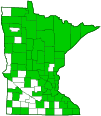Virginia ctenucha
(Ctenucha virginica)
Conservation • Description • Habitat • Ecology • Distribution • Taxonomy
|
|
||||||||||||||||||
Description |
Virginia ctenucha is a colorful, medium-sized moth. It is the largest wasp moth in North America. The adult is 15 ⁄16″to 1 1 ⁄16″ long and has a wingspan of 1 9 ⁄16″ to 2″. The abdomen is metallic blue. The thorax is black and metallic blue. There are yellowish-orange scales on the sides of the first section of the thorax (prothorax) forming a collar. The collar does not extend across the upper (dorsal) surface of the prothorax. The forewings are dark grayish-brown with a metallic blue sheen at the base. The leading edge of the forewing (costa) is dark grayish-brown. The hindwings, not visible when perched, are smaller and black. Both wings have a short fringe that is at least partially white. The head is yellowish-orange. The antennae are feather-like with branches only on one side of most segments. The caterpillar is ⅝″ to 1 9 ⁄16″ long. The thorax and abdomen are nearly black. There is a broken, cream-colored subdorsal stripe and a broken, white, subspiracular stripe. On later instars the body is mostly hidden beneath dense tufts of long, stiff hairs (seta). Middle instar caterpillars lack these long white seta. There is a center (middorsal) row of black tufts flanked by rows of white, blond, or yellow tufts. The black tufts may be obscured by the longer flanking tufts. The head is orange to red except for a black triangular area between the eyes (frons). The abdominal leg-like structures (prolegs) are reddish. Mature caterpillars are found in May to early June and again in the fall. |
Size |
Wingspan: 1 9 ⁄16″ to 2″ Total length: 15 ⁄16″to 1 1 ⁄16″ |
Similar Species |
Yellow-collared scape moth (Cisseps fulvicollis) is smaller and has much narrower wings. The discal area of the hindwing is translucent. The basal half of the costa is yellow. The thorax is black. The yellowish-orange collar extends evenly across the nape of the neck. |
Habitat |
Moist, open, grassy fields and meadows. |
Ecology |
Season |
One generation: Mid-June to late July |
Behavior |
Adults fly primarily during the day, but are also attracted to light at night. |
Life Cycle |
Caterpillars overwinter beneath leaf litter or matted grass. |
Larva Hosts |
Mostly grasses, but also sedges and irises. |
Adult Food |
Flower nectar |
Defense Adaptations |
This and other Ctenuchid moths have three adaptations that help to protect them from predators; aposematism, sound production, and pyrrolizidine alkaloid sequestration. Aposematism: The metallic blue color of the thorax and abdomen mimics wasps which may be noxious to predators. Sound production: A specialized (tymbal), corrugated region on the third section of the thorax (metathorax) produces ultrasonic sounds which interfere with (“jam”) the sonar of moth-eating bats. Pyrrolizidine alkaloid sequestration: Caterpillars acquire and retain naturally produced toxic chemicals (pyrrolizidine alkaloids) from the plants they eat. |
Distribution |
||
|
Sources |
|
| 6/17/2025 | ||
Occurrence |
||
Widespread and common |
||
Taxonomy |
|
Order |
|
Superfamily |
Noctuoidea (owlet moths and allies) |
Family |
Erebidae (underwing, tiger, tussock, and allied moths) |
Subfamily |
Arctiinae (tiger moths and allies) |
Tribe |
Arctiini (tiger moths) |
Subtribe |
Ctenuchina (handmaidens) |
Genus |
Ctenucha |
In 2011 the family Arctiidae (tiger moths and lichen moths) was transferred to the family Erebidae mostly intact but demoted to a subfamily. The former subfamilies are now tribes, the former tribes now subtribes. |
|
Subordinate Taxa |
|
|
|
Synonyms |
|
Ctenucha latreilliana |
|
Common Names |
|
Virginia ctenucha Virginia ctenucha moth |
|
Glossary
Collar
In grasses: The area on the back of a grass leaf at the junction of the sheath and the blade. On moths: the upperside of the prothorax.
Costa
In plants: The central axis of a pinna, to which pinnules are attached. In Lepidoptera: The leading edge of the forewing.
Proleg
A fleshy structure on the abdomen of some insect larvae that functions as a leg, but lacks the five segments of a true insect leg.
Prothorax
The first (forward) segment of the thorax on an insect, bearing the first pair of legs but not wings.
Seta
A usually rigid bristle- or hair-like outgrowth on butterflies and moths used to sense touch. Plural: setae.
Visitor Photos |
||
Share your photo of this insect. |
||
This button not working for you? |
||
Kaylan Petrie |
 |
spotted in grassy field near organic farm |
Babette Kis |
||
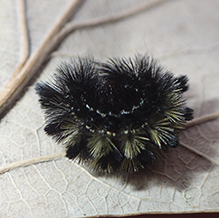 |
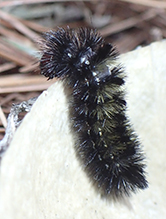 |
|
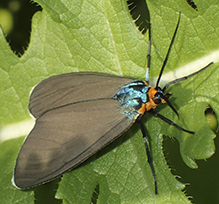 |
||
Bobbi Johnson |
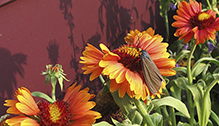 |
Was found in my newly made garden. |
Luciearl |
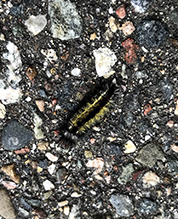 |
Dan W. Andree |
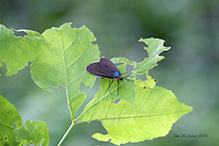 |
Alfredo Colon |
||
A beautiful Moth... from Lake Elmo Park Reserve, MN |
||
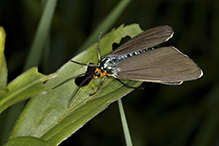 |
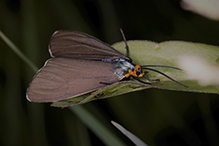 |
|
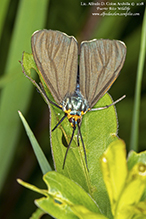 |
||
Bill Reynolds |
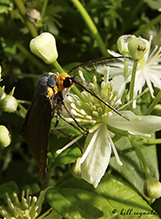 |
Virginia Ctenucha on Virgin Bower |
MinnesotaSeasons.com Photos |
||
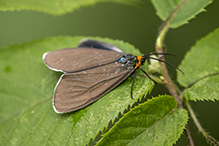 |
 |
|
Adult |
Adult |
|
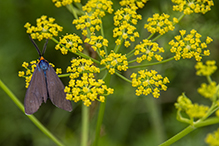 |
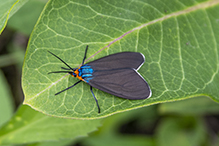 |
|
Adult |
Adult |
|
|
||
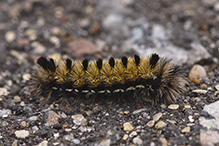 |
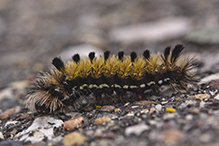 |
|
Middle instar caterpillar |
Middle instar caterpillar |
|
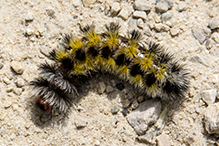 |
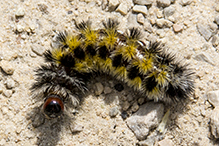 |
|
Middle instar caterpillar |
Middle instar caterpillar |
|
 |
||
Middle instar caterpillar |
|
|

Slideshows |
Virginia Ctenucha Moth |

|
About
Ctenucha virginica larva: bugguide.net/node/view/72418 |
Ctenucha virginica (Virginia Ctenucha) |

|

Visitor Videos |
||
Share your video of this insect. |
||
This button not working for you? |
||
|
Other Videos |
||
Virginia Ctenucha Moth (Arctiidae: Ctenucha virginica) with Mosquito |
About
Uploaded on Jun 14, 2010 Sometimes the mosquitoes in North Dakota are so numerous that they must occasionally find places to perch on other insects. ;-) Photographed at Turtle River State Park, North Dakota (14 June 2010). |
Ctenucha Virginica moth feeding on Apocynum cannabinnum |
About
Uploaded on Jun 30, 2009 In late June and July day flying moth Ctenucha virginca, commonly called Ctenucha moth of Arctidae are seen commonly nectaring on flowers of Asclepias. Apocynum, sweet clover etc. The blue on the head and shoulder, to me looks like hind of a frog, may be a poisonous dendrobid frog. |
Virginia Ctenucha Moth (Arctiidae: Ctenucha virginica) Male on Leaf |
About
Uploaded on Jun 17, 2010 Photographed at the Rydell NWR, Minnesota (16 June 2010). |
Virginia Ctenucha Moth (Erebidae: Ctenucha virginica) on Grass |
About
Uploaded on Jul 3, 2011 Photographed at Nisswa, Minnesota (01 July 2011). |
Virginia Ctenucha Moth, Ctenucha virginica |
About
Published on Feb 9, 2014 This beautiful Virginia Ctenucha Moth was in my garden feeding on some Echinacea purpurea 'Prairie Splendor'. |

Visitor Sightings |
||
Report a sighting of this insect. |
||
This button not working for you? |
||
Kaylan Petrie |
Location: Manton, MI spotted in grassy field near organic farm |
 |
| Jean Fenton 6/29/2023 |
Location: E7140 610th AVE, Elk Mound, WI I … the electric blue body when it spreads its wings |
|
| Bobbi Johnson 7/10/2021 |
Location: Silver Bay, MN Was found in my newly made garden. |
 |
| Babette Kis 6/7/2021 |
Location: Barnes Prairie, Racine Co., WI |
| Luciearl 5/23/2020 |
Location: Cass (Cty Rd 77) |
 |
| Adliner 6/21/2018 |
Location: Woodbury, MN This moth is beautiful. It was resting on a milk weed plant in my garden |
|
| Alfredo Colon 6/10/2018 |
Location: Lake Elmo Park Reserve, MN A beautiful Moth... |
 |
| Babette Kis 11/28/2017 |
Location: Barnes Prairie, Racine Co., WI |
| Dan W. Andree 2016 |
Location: Taken in an area of mixed woods near a tributary to the Wild Rice River in Norman County, Mn. |
 |
| Bill Reynolds 7/21/2006 |
Location: Pennington Co. Virginia Ctenucha on Virgin Bower |
 |
MinnesotaSeasons.com Sightings |
||

Created: 9/28/2014 Last Updated: © MinnesotaSeasons.com. All rights reserved. |
